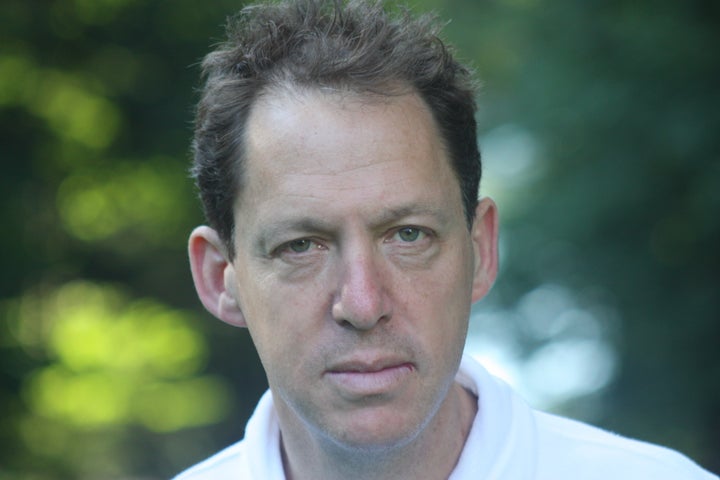
Paul Holdengräber, Photo Courtesy of Oliver Holdengräber
Paul Holdengräber, Host of LIVE from NYPL
by Joy E. Stocke and Kim Nagy
I think, at a child’s birth, if a mother could ask a fairy godmother to endow it with the most useful gift, that gift would be curiosity. – Eleanor Roosevelt
On a glorious sunlit afternoon at a café table beneath the London plane trees in the New York Public Library’s outdoor living room, Bryant Park, Paul Holdengräber, creator and curator of the LIVEfromNYPL interview-conversation-happening series, empties his pockets and spreads out their contents: a wallet, bits of notepaper, loose change, and a set of keys for the new home he’s settling into with his wife and two sons.
“These are important,” he smiles, holding up the keys. “I had better not lose them or I won’t get back in.” The doors those keys open, and what waits beyond the threshold, could be a metaphor for the series itself, now in its twelfth year, a series that remains fresh, surprising, intellectually rigorous, and playful. This year’s guests include the actor Alan Cumming, who opened this year’s series; photographer Sally Mann; performance artist Marina Abramović in conversation with punk rock trailblazer Debbie Harry; architects Daniel Libeskind, Steven Holl, and Elizabeth Diller; the novelist T.C. Boyle; and the musicians Robbie Robertson and Steve Van Zandt.
Whether Holdengräber is in direct conversation with his guests or curating conversations between the guests themselves, he becomes immersed in their work, and additionally studies every aspect of their lives, revealing bits of himself in the process.
“It’s about creating the space for potential. I don’t mind awkward pauses or silence,” he notes. “In fact, I rather like them. So, one of my goals at this stage of life is … I don’t know how your pockets are, but mine are very messy. And when I take things out, God knows what I’ll discover.”
Emptying one’s pockets has a literal meaning for Holdengräber, but there is more at stake. He is invoking the great English psychoanalyst and essayist Adam Phillips, who says that when we speak to each other things fall out of our pockets.
This is exactly how Holdengräber envisions his interviews and conversations––things inadvertently and not falling out of pockets in speech. Holdengräber also connects each guest to the world-famous collections housed in the New York Public Library’s main branch, where its librarians were recently named the “Human Google.”
In fact, the New York Public Library, with more than 51 million items, holds treasures such as Christopher Columbus’s 1493 letter announcing his discovery of the New World, George Washington’s original Farewell Address, and John Coltrane’s handwritten score for Lover Man. “There are so many things NYPL does that spring from the collection of books,” says Holdengräber. “The books are, in a sense, the landscape from which we can operate. That’s why before an event, whenever possible, I always take people into the special collections.”
As LIVE settles firmly into its second decade, we were eager to revisit Holdengräber, whom we interviewed in 2011 in conjunction with the Rolex Mentorship program. He has lost none of his enthusiasm, believing as Ralph Waldo Emerson did that nothing great was ever achieved without enthusiasm. In fact, if curiosity is the key to the Fountain of Youth, Holdengräber possesses it in spades. But he also possesses curiosity’s mate, the desire to follow that curiosity wherever it leads.
“My appetite has not waned one bit,” affirms Holdengräber. “I remain convinced that conversation and exchange is at the heart at what is important––what keeps us vital. And that also our lack of it, generally speaking, is at the heart of the problems we have.”
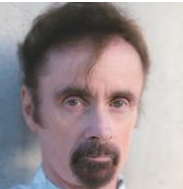
T. C. Boyle

Debbie Harry
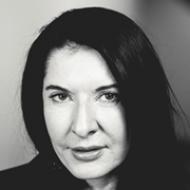
Marina Abramović
WRR: It’s a great pleasure to sit down with you again. And an even greater pleasure to feel your enthusiasm for the new season.
Holdengräber: And for me as well. You know, in 2004, when the former NYPL president Paul LeClerc called me in Los Angeles where I was the Director of the Institute for Arts and Cultures at the Los Angeles County Museum of Art (LACMA) and asked me to “oxygenate” the library, I had no intention of moving to New York. But I was intrigued by the challenge of bringing all that the library contains––which is much more than simply the collections of books––to an audience who would enlarge the conversation. In fact, here in Bryant Park we are literally sitting upon books since the stacks are right below us. So, when I accepted the offer, I literally took him at his word. I uprooted my family from beautiful Santa Monica and we went from a very blissful life near the beach to the glorious hurly burly of New York.
WRR: Were there many programs like LIVE at the time?
Holdengräber: There were fabulous programs at the 92nd Street Y and at the Metropolitan Museum of Art and at the Brooklyn Academy of Music (BAM) and elsewhere, but nothing at the library. Most people didn’t think of the library in that light.
WRR: You are a master of using quotations to great effect, not only to make a point, but also to put people at ease, to make us think, of course. But also to make us laugh.
Holdengräber: Well, it’s my quotomania. A disease from which I wish no cure. I always rely on these quotations, not really to impress but because they are like signposts of my life and also markers in terms of how people react to the various situations and conflicts.
Like keys. In a metaphorical sense, we might ask, “What is the key? And, how do I discover it? And, is the key I’m holding actually the key I’m after?” In many ways, the greatest compliment I can get is when I finish an interview with someone I admire, not yet knowing which keys I have used to open which doors; and a lover, a husband, a wife, or someone who knows the person well, says, “What a revelation. I never heard him or her say that before. I didn’t know that about them.”
I did an interview for the Paris Review with Adam Phillips––the first time in over half century that the Paris Review featured a psychoanalyst as the subject of an interview. And at the end of the introduction to that interview, Adam says, “Digression is secular revelation.” That interview is the fruit of a decade-long conversation I have been having with Adam––yes over ten years of speaking to each other––much like an analysis itself.
WRR: What you’re saying is that a set of keys, or the research you do before an interview, allows you the space for digression. But, a key also allows you to become the driver.
Holdengräber: When we talk about digression, we’re talking about getting lost, about taking the side roads, or the road just behind the road we thought we were taking. What doesn’t quite fit, what might be dismissed, but isn’t, becomes the road to revelation. Charlie Mingus said, “Improvisation, yes; but you need to improvise on something.” Although showing up is important, a good interview doesn’t come just because you show up. You have to create the conditions for conviviality. I must say, after being here for a decade and 500 events, I can certainly think about my shortcomings. But, for me, the success is that I’ve created space for attention and tension.
WRR: Attention and tension? Holdengräber: Many, but not all, guests I interview feel a bit of both. There are people who perform before crowds as large as 30,000 people, but an intimate venue like the Celeste Bartos Forum can make them feel exposed. Yet, in creating that tension, you must also pay attention to the audience. In this discombobulated, distracted world where any of us are doing a hundred different things at the same time, I ask myself, How do we create a world where we remain attentive to someone for about two hours? Which sometimes seems very long to people because they’re used to an interview happening quickly. Katherine Hepburn said that she was so very much looking forward to dying so that she wouldn’t have to do any more interviews. When I read that I thought, if only I could speak to her for two hours.

Paul Hodengräber and Laurie Anderson - Photo Courtesy of LIVEfromNYPL
WRR: After more than ten years, are you still as excited as that first day when you made the lions roar?
Holdengräber: An Israeli friend of mine recently said, “Paul, soon you will have spoken to everyone.” And I suppose it’s correct in some way. I’ve spoken to such a variety of people that one could think, which the statement implies, in some way there’s wear and tear and there’s fatigue and that maybe it’s enough. But I don’t feel it. I still feel real excitement. I felt it when I was talking with Laurie Anderson who closed our last season. She trusts laughter over intelligence. Not only was she magnificent and passionate and funny, but she was also luminescent.
WRR: How do you choose whom you interview, or who appears together on the LIVE stage? In a sense, you are choreographing a larger story over the course of a season.
Holdengräber: The interviews arise from conversations like ours. The big problem I face is that there are many people I would like to interview, but I have to consider whether they have resonance in a crowd. For instance, it is hard to take the academy out of its natural setting. But my conversation with the great Italian and eminent historian Carlo Ginzburg, who has grappled with persecution and identity and who should be heard by so many more people than naturally hear him, held the audience spellbound from the first question until the last.
WRR: An interesting element of LIVE is that while you interview many guests, you also curate and facilitate conversations between guests.
Holdengräber: I have a yearning to speak to certain people, and a sense that a pairing is good, such as the recent conversation between Margaret Atwood and Fiona Shaw. But, I always ask myself what would be best for the event? Sometimes guests “request” me––as a guest once said, for “the Holdengräber treatment,” which made me think that it was a form of (psycho) analysis. Being in treatment––yes, as in the Holdengräber treatment.
There are certain people I wish to talk to because I know so little––there we go again, with the “euphoria of ignorance”––and I become the spokesperson for the audience, that curator of public curiosity asking the questions perhaps on everyone’s mind in the audience, or perhaps not.
After all what did I know about Jay-Z , or RuPaul or for that matter Helen Mirren? But what JOY! The same is true for Mike Tyson. I wish to take my guest out of the specialist in conversation––the (often deadly) academic discourse. As for preparing my guests to be in conversation with someone of equal accomplishment whom they’ve most likely not met before, I always, or most always, have a conference call with the participants. But also, I conduct the conversation because I believe that improvisation is something one prepares for (to a point). And so, I have people talking to each other mostly over the phone and briefly, so as not to lose the magic in the green room.
WRR: The New York Public Library system, like all library systems, has evolved since you began LIVE.
Holdengräber: The question becomes how do we make the materials more available, yes––we need to grow our online presence or “our digital footprint,” as the library is doing successfully and continues to do. We have to ask, how can what we experience here at the library become a shared experience with the larger public? Because our community is much more than geographically local.
WRR: We enjoy following you at @Holdengraber on Twitter.
Holdengräber: I do like Twitter because the form is concise and compatible with quotes. But we have a fantastic team who are experts in their fields to make sure we spread our messages effectively. Since the beginning of LIVE, I’ve been asking my guests to describe themselves in seven words, which lends itself beautifully to the Twitter platform. Guests at LIVE have often heard my seven words: “My mother said, ‘You have two ears, one mouth.’” That’s one of the reasons I like Twitter. Someone read that quote on Twitter and gave me the whole background to that story. They told me that it is attributed to Zeno, one of the Pre-Socratic philosophers. And so, they sent a T-shirt to me with the quote in Greek.
But Twitter is a very interesting medium in which to discover all kinds of tidbits of information. In a way it’s like the florilège––which literally means a beautiful bouquet of flowers as does an anthology––the sum of what is beautiful in culture. From time to time on Twitter you can find these tidbits. Of course, Twitter contains all that is beautiful as well as crass in our culture.
WRR: But you always bring your social media platform back to the physical, back to the library and LIVE.
Holdengräber: Most people get their information through social media, but people still want to engage in cultural events. In this city, on any given night, when we have an event at NYPL, there might be twenty-five other events going on. The truth is that if I were on the other side of what I do; if I wanted to expand my mind in that way, I would be truly torn because there are so many different things happening of equal and diverse quality. I’m very heartened by that. You know, people say that they were inspired by the creation of LIVE and have taken it to other places. And people constantly ask me, How did you go about creating it? And I have no idea. As the philosopher Hegel said, “The Owl of Minerva spreads its wings only at the falling of dusk.”
But I have seen a real hunger connected to the fact that we live our lives in such separate units isolated in front of screens, myself included. We want to come together. We want to feel other bodies in the room with us, listening and having the same experience, that heightened moment––two hours at most of being on stage––lives on in the memory. And it lives on quite physically online because you can see it. There is an afterlife of the conversation that continues.
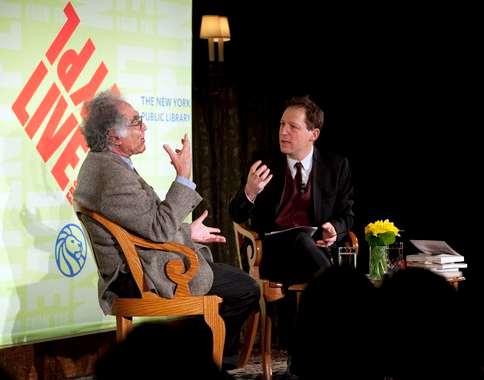
Carlo Ginzburg and Paul Holdengräber - Photo Courtesy of LIVEfromNYPL
I always bring up my parents. When I visited my mother in Brussels, she would ask me, “Who are you speaking to next?” I interviewed Mike Tyson, certainly one of the most eloquent, vulnerable, violent people I’ve met, shortly before my mother died and it became one of her favorite interviews.
She posed a question, which I asked him: “What does it feel like to be so forcefully hit on your head?” He said, “What I did for a living is what you should try to avoid for your whole life.”
In those words, he spoke about the pain. He spoke about what it felt like without ever saying it. And these heightened moments with someone like Tyson, someone like Laurie Anderson, every aspect of a conversation takes them out of their specific sphere and on the uncharted road.
WRR: You also took Tyson, as you do all your guests, to see the library’s special collections.
Holdengräber: I took Tyson into the reading room; and then, yes, into the special collections and showed him a first edition of Machiavelli. He said that there may be an earlier edition, and he was right. I remember saying to him, “It’s amazing how immersed you are in the reading room.” And he said, “A room without books is like a body without the soul,” which is a line from Cicero. So there I was, with the world’s greatest heavyweight quoting Cicero. We had invited a hundred boxers into the room and after that, many of them felt it was cool to read. And cool to come to the library. And so, the library, which to my mind, is the Ellis Island of New York, the point of entry, becomes the welcoming point of the city. If you think of it in terms of the émigré, it was their living room when they didn’t have one. Now it’s transformed yet again. It’s not only the living room, it’s also a place where people congregate around ideas and can learn from a boxer.

Mike Tyson
WRR: When you share something specific with your guests it can be incredibly disarming.
Holdengräber: You know, I do this for so many reasons. One of them is strategic. One of them is simply that many people who take to the stage are terrified. They’re fearful that they might slip, that they might say something or that they may not have an answer to a question. I have countless examples of people to whom I said, “I really want to bring out the best in you.” Also, I really don’t mind awkward silences. I actually quite like them.
WRR: There was a point in your interview with Tyson when he said, “I’m not an incredible fighter. I’m an incredible student.”
Holdengräber: The special collections is a way to anchor the experience of our guests in the space. We’re not a shopping mall. The library is not a venue. There are seven floors of books and nearly 52 million items. It’s important that Neal Gaiman see the skull of Percy Bysshe Shelley. It’s important for basketball player Shaquille O’Neal, possibly one of the tallest athletes at 7 foot 6 inches, to hold the smallest book we have.
The greatest treasure of all that we have at the library are the curators who come up with these wonderful ideas and pair our guests with items full of meaning. In this case, Thomas Lannan, Isaac Gerwitz, Michael Inman, and so many other curators. All I tell the curators before inviting a guest is, “Surprise Us.” We showed Roseanne Cash Shakespeare’s first folio that had probably been touched by the poet Ben Jonson. The curator said that you too can put your hand on it. Roseanne certainly felt some form of tactile inebriation, something transmitted from more than 400 years ago.
WRR: From our vantage point in the audience, your interviews are so very wide-ranging; and, as you said earlier, jazz at its best. How do you know when something is going off? How do you pull it back?
Holdengräber: I get a feeling in my stomach, my head, my muscles, my tissues. And so the question becomes, “What has my guest said that is intriguing? What can I further develop? And what have they not said that I should somehow bring up? It’s not about following a script. All I really know is more or less where I want to begin and more or less where I want to end.
Everything in between is a foreign country. If I am interested, possibly the public will be interested, too, and want to enter the artist’s world. I’m hoping that people who attend or watch the interviews online will want to immerse themselves in Laurie Anderson’s world, or Jhumpa Lahiri’s world, or Elvis Costello’s world. I’m hoping for those moments when people say, “Oh yes, I want to know more. I want to do something that is really diametrically opposed to what is happening in this room. I want to be alone in the company of the author, writer, poet, musician.”
There are times when I have to modulate and make myself a bit smaller or a bit less visible. And some times it’s not enough and I have to make myself bigger and more visible. That happens often when I have somebody who is shy or recalcitrant. Or someone who is terrified. There are quite a few people who are invited, but don’t want to be there. But they need to because they are on tour and it’s part of what you do. So, I want to give them the best night of their life with what they themselves have done or produced.
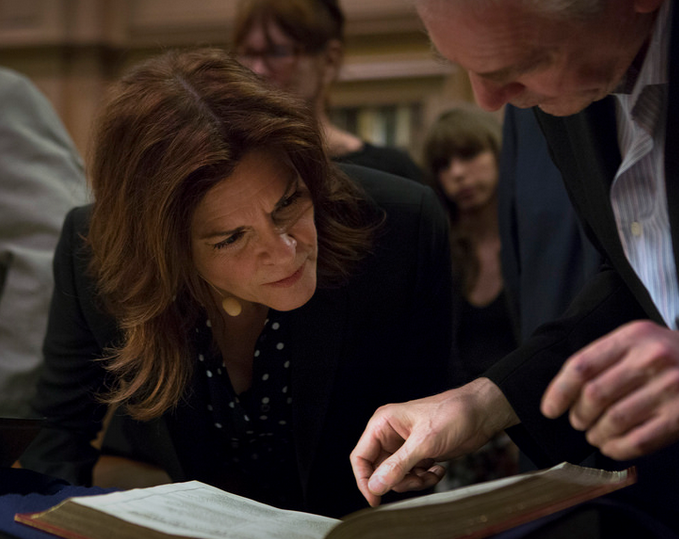
WRR: Your interviews interlink with other interviews over the years as if people have been talking to one another across time. Holdengräber: I try to create what I often refer to as an organized web of obsessions. Some of them are simply things I’ve been thinking about for years. One of them as I get older is the relationship between aging and taste. What did we care about once upon a time and what do we remain faithful to? I find myself asking those kinds of questions, which are really questions about reading and rereading.
WRR: Zadie Smith said when you write anything you reveal beliefs and they change over time.
Holdengräber: Remember her collection is called Changing My Mind. How do we change our minds? And I would say the way we change our minds is by being exposed to different viewpoints. Which is what I’m doing constantly. Surprise me. I wish to be surprised by myself.
WRR: One sort of paradigm doesn’t change. In Jhumpa Lahiri’s Interpreter of Maladies, the mother carries her native Calcutta in her soul. That was her cultural reference, her touchstone. You always bring passion and fire and vibrancy to each interview. And attention. Have your beliefs changed? What has changed or evolved for you over time?
Holdengräber: When you mentioned the word attention, I was thinking of the wonderful line by philosopher Simone Weil, who said, “Attention is a form of prayer.”
To me, to be attentive is a form of real distillation, a concentration in the literal sense. When you’re paying attention to something or someone, you are immersed in their world, as in the best literature.
If I’m not to calcify, I need to expand what I’m doing through so many other realms. And part of the goal for LIVE is that it remains alive to different points of culture. Because calcification of a thought or an idea or a way of being is contrary to life. It’s what makes us brittle and we break. And so, for me, the question becomes, what limits do I need to push? I’m keen to find out who should help me stretch the limits. Who would you really want to hear? Or, perhaps, whom have we not heard that we need still to hear? What and who would make us swoon? Tell me, please.
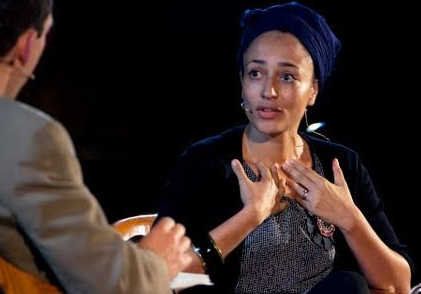
Paul Holdengraber & Zadie Smith, Photo Courtesy of LIVEfrom NYPL
To find out about the LIVEfromNYPL Season click here: LIVEfromNYPL
To view shorts from LIVEfromNYPL Interviews and conversations, click here: LIVE SHORTS
To read more interviews and features about LIVE on the Wild River Review website, click here: Wild River Review
Follow Paul Holdengräber on Twitter: @Holdengraber
Visit Wild River Review’s Facebook Page: Wild River Review
